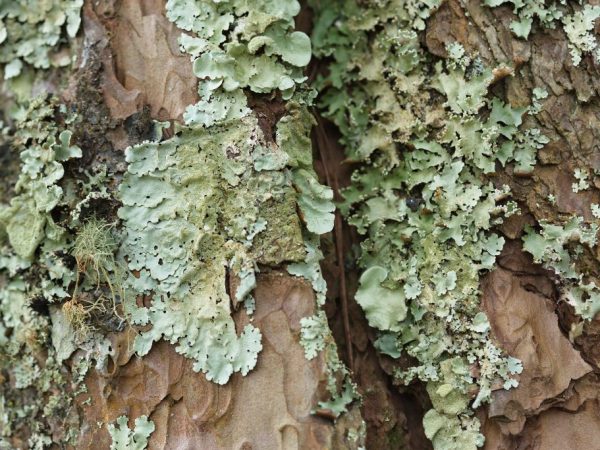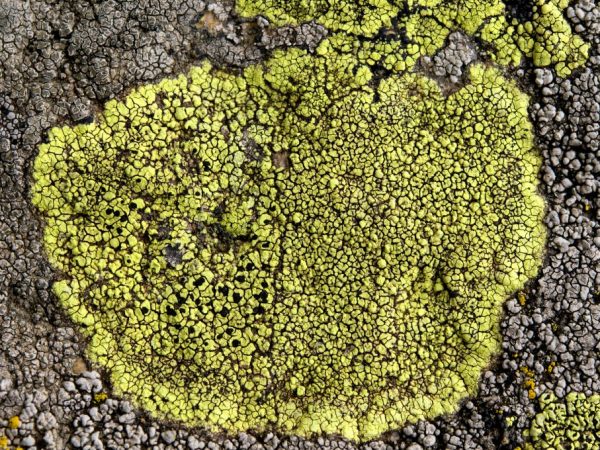Features of symbiosis of fungus and algae
The most mysterious symbiosis of fungus and algae is the Lichens section. An organism consisting of two components is investigated by a science called lichenology. Until now, scientists have not been able to establish the nature of their occurrence, and in laboratory conditions they are obtained with great difficulty.

Features of symbiosis of fungus and algae
Body composition
Previously, it was thought that the symbiosis of fungi and algae in a lichen is represented by a mutually beneficial way of coexistence of two organisms, in which:
- mushrooms receive carbohydrates produced by the second component in the process of photosynthesis;
- algae need minerals and a cover to protect themselves from drought.
But later this "safe" symbiotic organism has a new status. The interrelationships of organisms in it were recognized as parasitic. Because they discovered that under unfavorable conditions the fungus becomes a parasite. The algae may even die if the fungus eats not the carbohydrates it synthesizes, but its body.
Irina Selyutina (Biologist):
In 1873, the French researcher E. Borne, studying the anatomical structure of lichens, discovered fungal processes inside algal cells - haustoria, which suck up the organs of the fungus. This made it possible to think that the fungus uses the contents of algal cells, i.e. behaves like a real parasite. Over the years, many different forms of absorption, or suction, fungal hyphae have been discovered and described in the lichen thallus.
Now the union is presented in a different way: the spores of the fungus choose their "nurse", but the latter can resist the union. The main rule in symbiosis is mutually beneficial coexistence. A lichen will turn out if both components are experiencing difficulties in living alone: they lack food, light, and temperature. Favorable factors do not force them to unite.
Interacting fungi behave differently with algae. Forms hyphae with all available species, but some of them are simply eaten. Synthesis only occurs with similar classes. In coexistence, both organisms change their structure and appearance.
The structure of the body
Structurally, a lichen contains 2 components: fungal hyphae with algae woven into them.
The algal component - phycobiont, can be represented by cyanobacteria (blue-green algae), green or yellow-green algae. The fungal component, or mycobiont, is marsupial or basidiomycetes.
If the distribution of algae is uniform throughout the thallus, it is called homeomeric, and if only in the upper layer, heteromeric. This is the so-called thallus, or thallus, or the body of a lichen.
The internal structure of the lichen thallus includes the following components:
- Upper crust (cortex): formed by tightly intertwined hyphae. It is dyed in different colors due to the presence of pigments. This crust is thicker and provides protection and absorption of water from the air.
- Core layer: formed by the inner hyphae of the fungus and the green cells of algae, which are associated with photosynthesis, transformation and storage of substances.
- The lower skin (cortical layer): thin, equipped with outgrowths-rhizoids, due to which the body of the lichen is attached to the substrate. In addition, hyphae secrete acids that can dissolve the substrate and absorb minerals.
In appearance, the following types of thallus are distinguished:
- scale;
- leafy;
- bushy.
The former look like a thin crust firmly adhered to the surface. Leafy ones keep on bundles of hyphae - rhizoids. The bushy ones look like a drooping bush or beard.
The color can be gray, brown, greenish, yellow or black. The concentration is regulated by specific dyes, iron content, acids in the environment.
Breeding methods and life cycle

Lichens are resistant to lack of water
In a lichen, both components are endowed with the ability to reproduce. Fungal reproduces vegetatively - by parts of the thallus or by spores. The processes of the body break off from the thallus and are moved by animals, people, or the wind. Controversy also spreads.
The second component is divided vegetatively. The symbiotic complex improves the ability to reproduce. And some species practically do not exist outside the lichen.
Irina Selyutina (Biologist):
Lichens reproduce either by spores that form a mycobiont sexually or asexually, or vegetatively.
With sexual reproduction on the thalli of lichens as a result of the sexual process, sexual sporulation is formed in the form of fruiting bodies (apothecia, in lichens, perithecia, gastrothetia are known).
In addition to the spores formed during the sexual process, lichens are also inherent in asexual sporulation - conidia, pycnoconidia and stylospores that arise exogenously on the surface of conidiophores.
With vegetative propagation usually there is a separation of pieces of the thallus, which can be torn off by gusts of wind or media (microscopically small glomeruli consisting of one or more algal cells surrounded by fungal hyphae) or isidia (small outgrowths on the upper surface of the thallus).
Organisms grow slowly. Forms an increase per year from 0.25 to 10 mm. But they are undemanding to environmental conditions:
- grow on rocks, ground, trunks and branches of trees, on inorganic materials: glass, metal;
- withstand dehydration.
Resistant to temperatures ranging from -47 to 80 ℃, 200 species live in Antarctica. They were able to live outside the earth's atmosphere for about two weeks. Lichens are indicators of the cleanliness of the environment - they are not found in places with heavy pollution.
Role of lichens
There are about 20 thousand species. The symbiont forms a distribution network throughout the world. Organisms in tundra and forest areas are of particular importance:
- Serve as food for reindeer.
- They take part in the weathering of rocks and soil formation.
- Become a breeding and habitat for a number of invertebrates.
A person uses them:
- To determine the age of the rocks, the lichens themselves live up to 4500 thousand years.
- To obtain antibiotics, you need types of cetrarium, cladonia, parmelia, and sleeping.
- From lobaria and evernia, aromatics and odor fixers are obtained.
- Source of raw materials for industry (production of alcohol, dyes).
- Source of dyes and chemical indicators (litmus).
- Lichen acids are used in medicine as antibiotics (usnin).
- Bioindicators of medium purity.
Lichen manna is eaten in the deserts of the Middle East, and in Japan, edible umblicaria is considered a delicacy. The species of Fremont briory are edible.
Conclusion
The symbiotic union of the two organisms is still being investigated. If earlier it was possible to obtain in the laboratory only 1 organism per 800 attempts, now, thanks to discoveries, the study is progressing faster. In the best case scenario, both organisms benefit from coexistence.


